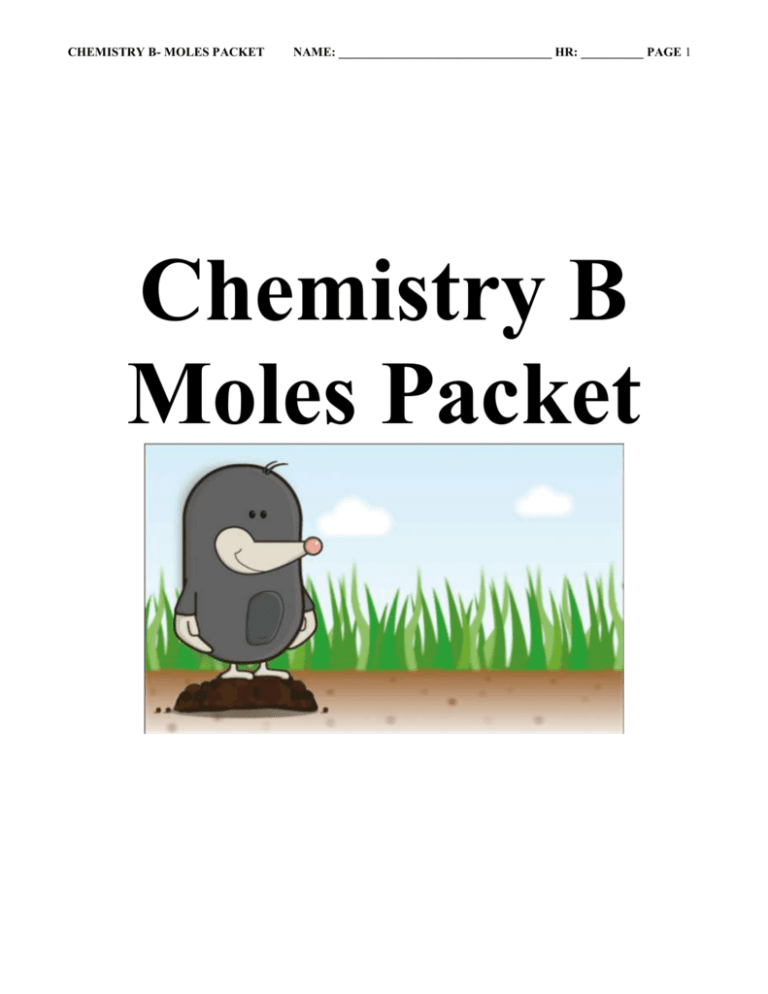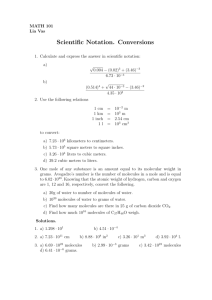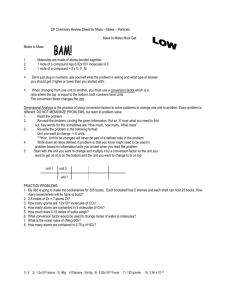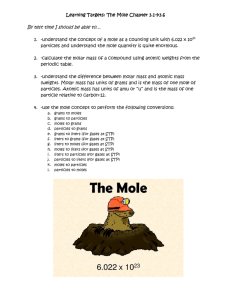chemistry worksheet # 2: the mole as a unit of mass
advertisement

CHEMISTRY B- MOLES PACKET NAME: __________________________________ HR: __________ PAGE 1 Chemistry B Moles Packet CHEMISTRY B- MOLES PACKET NAME: __________________________________ HR: __________ PAGE 2 INTRODUCTION TO MOLES We are about to start on a unit of chemical calculations called “stoichiometry”. Stoichiometry is how we calculate the relationships between the amounts of reactants and the amounts of products. For example, if we know the amount of reactants we have, we can use stoichiometry to calculate how many products the chemical reaction will produce. This packet provides an organized, step-by-step approach for these problems. If you follow this system and complete work each day as it is assigned, this will not be a difficult unit. That is good, because stoichiometry is one of the most central and important concepts in chemistry. It is essential that you understand this unit in order to move forward in chemistry. In short: do not fall behind or you will be lost. These problems involve numbers but no difficult mathematics. All you will ever have to do is add, multiply or divide. You will be expected to have a functioning calculator with you for every chemistry class. As we solve these problems we will apply the factor-label (dimensional analysis) method you mastered early in the class, and we will frequently use scientific notation. Remember in the factor-label packet you followed the procedure: what you are = what you are X looking for given a fraction or series of fractions where the = numerator is equivalent to the denominator answer The only new concept we will introduce in this unit is the idea of a mole. A mole is a quantity of matter that we use for conversion purposes. We can convert from grams to moles, liters to moles (for gases), and atoms or molecules to moles. If you can convert any of these things to moles (and therefore moles to any of these things) we can convert grams to liters or molecules, liters to grams of molecules, and molecules to liters or grams. Molar Mass (# grams) 6.02 X 1023 ATOMS (for elements) or 23 6.02 X 10 MOLECULES (for compounds) Atomic Weight (for elements) or Gram Formula/Molecular Weight (for compounds) MOLES 22.4 LITERS OF A GAS AT STP (standard temperature and pressure) CHEMISTRY B- MOLES PACKET NAME: __________________________________ HR: __________ PAGE 3 CHEMISTRY WORKSHEET # 1 MOLAR MASS (GRAM MOLECULAR/FORMULA WEIGHTS) We know that grams are actually a measure of the mass of matter and not the weight. Mass is the quantity of matter present; weight is a measure of the pull of gravity on matter and is measured in pounds or newtons. However, it is common usage in chemistry to talk about the “gram formula weight” rather than the technically correct term “gram formula mass” or “molar mass”. We have learned that the smallest particle of an element is an atom and the periodic table tells us the atomic masses or atomic “weights” for each element. We have also learned that the smallest unit of a compound are either molecules (for covalent compounds) or a collection of positive and negative ions (for ionic compounds). 1. What is the difference between mass and weight? 2. What unit is used to measure mass? Weight? 3. What is the small unit of a covalent compound? An ionic compound? Molar mass tells us the mass (“weight”) of 1 mol ofan atom or compound. In each case we simply calculate the sum of the “weights” of the atoms in the formula to determine the weight of a mole. These weights can be found on the periodic table. EXAMPLE: Calculate the molar mass (gram molecular weight) of a mole of iodine, I2. Round to 2 decimal places. 2 I = 2 X (126.90) = 253.80 g I2/mol EXAMPLE: Calculate the molar mass (gram formula weight) of a mole of aluminum sulfate, Al2(SO4)3. Round to 2 decimal places. 2 Al = 2 X (26.98) = 53. 96 3 S = 3 X (32.07) = 64.14 + 12 O = 12 X (16.00) = 192.00 __________________________________________ Al2(SO4)3 = 310.10 g Al2(SO4)3 /mol CALCULATE THE MOLAR MASS FOR THE FOLLOWING COMPOUNDS OR DIATOMIC ELEMENTS. SET UP EACH PROBLEM AS SHOWN IN THE EXAMPLE ABOVE. INCLUDE UNITS (G/MOL) FORMULA CALCULATION MASS OF A MOLE 1. water _______________ ________________ 2. calcium chloride _______________ ________________ 3. copper(II) sulfate _______________ ________________ 4. silver nitrate _______________ ________________ 5. sulfuric acid _______________ ________________ CHEMISTRY B- MOLES PACKET NAME: __________________________________ HR: __________ PAGE 4 FORMULA CALCULATION MASS OF A MOLE 6. calcium phosphate _______________ ________________ 7. sodium carbonate _______________ ________________ 8. ammonia _______________ ________________ 9. potassium chlorate _______________ ________________ 10. lead(II) nitrate _______________ ________________ 11. sodium oxalate _______________ ________________ 12. zinc chloride _______________ ________________ 13. magnesium oxide _______________ ________________ 14. antimony(III) chloride _______________ ________________ 15. nitrogen _______________ ________________ 16. oxygen _______________ ________________ 17. fluorine _______________ ________________ 18. chlorine _______________ ________________ CHEMISTRY B- MOLES PACKET NAME: __________________________________ HR: __________ PAGE 5 CHEMISTRY WORKSHEET # 2: THE MOLE AS A UNIT OF MASS Define the term molar mass (worksheet #1): _______________________________________________________ Now that you know how to find the mass of one mole of a substance (molar mass) you can easily find the mass of several moles or the mass of a fraction of a mole using the factor-label technique. EXAMPLE: What is the mass of 5.00 moles of water(H20)? 2 H = 2 x( 1.01) = 2.02 # grams H20 = 5.00 moles H20 x 18.02 g H20 = 90.10 g H2O O = 1 x(16.00) = 16.00 1 mole H20 H20 = 18.02 g NOW YOU TRY ONE: What is the mass of 0.50 moles of calcium carbonate(CaCO3 )? Ca = #g CaCO3 = C = 3O = CaCO3 = USE A SEPARATE SHEET OF PAPER TO SOLVE THE FOLLOWING PROBLEMS. SHOW YOUR WORK. ROUND MOLAR MASSES TO TWO PLACES AFTER THE DECIMAL. ADD UNITS. 1. How many grams are there in 5.00 moles of lead? 2. How many grams are there in 2.00 moles of sulfuric acid? 3. How many grams are there in 0.250 moles of sodium hydroxide? 4. How many grams are there in 2.50 moles of potassium nitrate? 5. How many grams are there in 10.0 moles of lithium carbonate? #1-5: You are given the number of moles and asked to find the grams (mass) MOLS GRAMS Now that you know how to find the mass of one mole of a substance you can easily find the number of moles there are in a given mass of the substance. EXAMPLE: How many moles of calcium chloride are there in 333 grams of calcium chloride (CaCl 2 )? Ca = 1 x(40.08)= 40.08 2 Cl = 2 x(35.45)= 70.90 CaCl2 = 110.98 g # moles CaCl2 = 333 grams CaCl2 x 1 mole CaCl2 = 3.00 mole CaCl2 110.98 g CaCl2 USE THE SAME PAPER AS THE ABOVE PROBLEMS TO SOLVE THE FOLLOWING. SHOW YOUR WORK AND PUT UNITS ON EACH ANSWER! 6. How many moles of silver nitrate are there in 80.00 grams of silver nitrate? 7. How many moles of phosphoric acid are there in 658 grams of phosphoric acid? 8. How many moles of tin (II) fluoride are there in 908 grams of tin (II) fluoride? #6-10: You are given the grams (mass) and asked to find the number of mols GRAMS MOLS 9. How many moles of hydrogen peroxide (H2O2) are there in 1000.0 grams of hydrogen peroxide? 10. How many moles of magnesium chloride are there in 148 grams of magnesium chloride? CHEMISTRY B- MOLES PACKET NAME: __________________________________ HR: __________ PAGE 6 CHEMISTRY WORKSHEET # 3 AVOGADRO’S NUMBER One important property of a mole is that it means a definite number of particles just like a dozen means a number of particles. While a dozen is only 12 particles a mole is a much larger number—6.02 x 1023 particles. Elements generally exist as the particles we call atoms. A mole of carbon contains 6.02 x 1023 atoms of carbon. A mole of helium contains 6.02 x 1023 atoms of helium. A mole of sodium contains 6.02 x 1023 atoms of sodium. A mole of gold contains 6.02 x 1023 atoms of gold. However, we have learned about seven elements that exist as diatomic molecules—H2, N2, O2, F2, Cl2, Br2, and I2. For these elements one mole is 6.02 x 1023 molecules. That is, 6.02 x 1023 molecules of hydrogen is one mole of hydrogen, 6.02 x 1023 molecules of nitrogen is one mole of nitrogen, 6.02 x 1023 molecules of oxygen is one mole of oxygen, etc. While atoms are the smallest part of an element that still retains the properties of that element, molecules are the smallest parts of covalent compounds that still retain the properties of that compound. (For ionic compounds the smallest part is a combination of + and – ions but for now lets just consider them to be “molecules”.) Therefore, one mole of a compound contains 6.02 x 1023 molecules of that compound. One mole of water contains 6.02 x 1023 molecules of water, one mole of carbon dioxide contains 6.02 x 1023 molecules of carbon dioxide, one mole of ammonia contains 6.02 x 1023 molecules of ammonia, one mole of sodium chloride contains 6.02 x 1023 “molecules” of sodium chloride, etc. (The number 6.02 x 1023 is a measurement, not a definition, and is only good for three significant figures.) In all of the above examples one mole of any substance contained the same number of particles. But remember, they all had different masses. The mass of one mole of each material was equal to the gram formula weight. (This is the same idea as the mass of a dozen. A dozen eggs, a dozen bricks, a dozen dump trucks all contain twelve items but the mass of a dozen eggs is certainly much different than the mass of a dozen bricks which is much different from the mass of a dozen dump trucks!) The number 6.02 x 1023 is known as Avogadro’s number in honor of an Italian Professor of physics, Amadeo Avogadro, who did considerable work on the development of atomic theory and the mole concept in about 1810. Given this number we can calculate the number of particles in a known number of moles or the number of moles in a given number of particles. EXAMPLE: How many molecules of water are there in 3.00 moles of water? # molecules H20 = 3.00 moles H20 x 6.02 x 1023 molecules of H20 = 1.81 x 1024 molecules H20 1 mole H20 EXAMPLE: How many moles of neon are there in 2.408 x 1024 atoms of neon? # moles Ne = 2.408 x 1024 atoms Ne x 1 mole Ne = 4.00 moles Ne 6.02 x 1023 atoms of Ne USE A SEPARATE SHEET OF PAPER TO SET-UP AND SOLVE THE FOLLOWING PROBLEMS. How many molecules are there in: 1. 2.00 moles of ammonia? How many moles are there in: 6. 3.612 x 1024 molecules of phosgene? 2. 0.50 moles chlorine? 7. 3.01 x 1023 molecules of freon? 3. 0.250 moles oxygen? 8. 1.505 x 1024 molecules of sucrose? 4. 4.00 moles of sulfur dioxide? 9. 1.806 x 1024 molecules of bromine? 5. 2.50 moles of methane? 10. 3.01 x 1024 atoms of argon? CHEMISTRY B- MOLES PACKET NAME: __________________________________ HR: __________ PAGE 7 CHEMISTRY WORKSHEET # 4 MOLAR MASSES AND AVOGADRO’S NUMBER Now that you know two definitions of a mole (a gram formula weight and an Avogadro’s number of particles) you can combine these two definitions into one problem. EXAMPLE: How many molecules are there in 90.1 grams of water? 2 H = 2 x(1.01) = 2.02 O = 1 x (16.00) = 16.00 H2O = 18.02 g # molecules H2O = 90.1 g H2O x 1 mole H2O x 18.02 g H2O 6.02 x 1023 molecules H2O = 3.01 x 1024 molecules H2O 1 mole H2O EXAMPLE: What would be the mass of 3.01 x 1023 molecules of ammonia (NH3)? N = 1 x (14.01) = 14.01 3 H = 3 x (1.01) = 3.03 NH3 = 17.04 g # grams NH3 = 3.01 x 1023 molecules NH3 x 1 mole NH3 x 17.04 g NH3 = 8.52 g NH3 6.02 x 1023 molecules NH3 1 mole NH3 SOLVE THE FOLLOWING PROBLEMS ON A SEPARATE SHEET OF PAPER. YOU MUST SHOW ALL OF THE STEPS AND YOU MUST DO THE PROBLEM JUST AS ILLUSTRATED. INCLUDE UNITS! 1. How many molecules are there in 345 grams of carbon dioxide? 2. What would be the mass, in grams, of 1.204 x 1024 molecules of sulfur dioxide? 3. How many molecules of sucrose, C12H22O11, are there in 454 grams of sucrose? 4. What would be the mass, in grams, of 1.806 x 1024 molecules of carbon monoxide? 5. How many molecules of water are there in 8.050 x 103 grams of water? 6. How many oxygen molecules are in a flask that contains 1.43 grams of oxygen? 7. What would be the mass, in grams, of 1.505 x 1023 molecules of carbon disulfide? 8. How many molecules of hydrogen chloride would there be in 100.00 grams of this gas? 9. What would be the mass, in grams, of 2.408 x 1024 molecules of tetraphosphorus decaoxide? Extra Challenge: 10. How many hydrogen molecules are there in 1 ton of hydrogen? (Hint: How many grams are there in 1 ton?) CHEMISTRY B- MOLES PACKET NAME: __________________________________ HR: __________ PAGE 8 CHEMISTRY WORKSHEET # 5 MOLE PROBLEMS—MOLAR VOLUME OF A GAS We have learned that a mole is a mass of material and number of particles. A mole can also be a measure of volume when we are talking about gases. You may remember from previous science classes that all gases behave basically the same as far as the physical properties of temperature, pressure and volume. AVOGADRO’S HYPOTHESIS SAYS THAT EQUAL VOLUMES OF GASES AT THE SAME TEMPERATURE AND PRESSURE CONTAIN EQUAL NUMBERS OF MOLECULES. Avogadro’s statement makes sense and is possible because gases are mainly empty space—only about one thousandth of the space is actually filled with molecules. The molecules “fill” the remaining space by moving rapidly through it. So the difference in size between large molecules and small molecules is insignificant compared to the total volume the gas occupies. At standard temperature and presssure (STP = OoCelcius and 1.00 atm pressure) one mole of any gas will have a volume of 22.4 liters. In other words, THE MOLAR VOLUME OF ANY GAS IS 22.4 LITERS AT STP. Once we know this we can convert from moles to liters or liters to moles for any gas at STP. EXAMPLE: What is the volume, in liters, of a 2.00 mole sample of methane (CH4) at STP? # L CH4 = 2.00 moles CH4 x 22.4 L CH4 = 44.80 L CH4 1 mole CH4 EXAMPLE: How many moles of ethane (C2H6) are there in 5.60 liters of ethane? # moles C2H6 = 5.60 L C2H6 x 1 mole C2H6 = 0.25 mole C2H6 22.4 L C2H6 COMPLETE THE FOLLOWING PROBLEMS ON A SEPARATE SHEET OF PAPER USING THE SAME SET-UP AS SHOWN ABOVE. WRITE THE FORMULAS FOR THE COMPOUNDS, NOT JUST THE NAMES. INCLUDE UNITS! 1. What is the volume, in liters, of 2.00 moles of hydrogen at STP? 2. How many liters will 5.00 moles of oxygen occupy at STP? 3. What is the volume, in liters, of 0.250 moles of carbon monoxide at STP? 4. What is the volume, in liters, of a 3.00 mole sample of carbon dioxide at STP? 5. How many moles of chlorine are there in a 67.2 liter sample of chlorine at STP? 6. A 44.8 liter sample of nitrogen at STP will contain how many moles of nitrogen? 7. How many moles of ammonia are there in 405 liters of ammonia at STP? 8. How many moles of neon would you need to fill a 33.6 liter container at STP? 9. How many moles of argon are there in 5.00 x 102 liters of argon at STP? 10. What is the volume, in liters, of 4.50 moles of fluorine at STP? Extra Challenge 11. How many moles of nitrogen are there in a 16,500 mL sample of nitrogen at STP? CHEMISTRY B- MOLES PACKET NAME: __________________________________ HR: __________ PAGE 9 CHEMISTRY WORKSHEET # 6 MIXED MOLE PROBLEMS (GRAMS, MOLECULES, AND LITERS) You now know three things a mole can be: a molar mass, 6.02 x 1023 molecules and, for a gas, 22.4 liters at STP. We can use this information to convert grams to molecules or liters, molecules to grams or liters, or liters to grams or molecules. # GRAMS Molar mass (grams per mole) 6.02 X 1023 atoms or molecules per mole # MOLECULES # MOLES 22.4 liters of gas per mole # LITERS (at STP) EXAMPLE 1: What would be the volume in liters of 40.36 grams of neon at STP? # liters Ne = 40.36 g Ne x 1 mole Ne x 22.4 L Ne = 44.80 L Ne 20.18 g Ne 1 mole Ne EXAMPLE 2: How many molecules would there be in 56 liters of carbon dioxide at STP? # molecules CO2 = 56.0 L CO2 x 1 mole CO2 x 6.02 X 1023 molecules CO2 = 1.51 x 1024 molecules CO2 22.4 L CO2 1 mole CO2 SOLVE THE FOLLOWING PROBLEMS ON A SEPARATE SHEET OF PAPER. YOU MUST USE COMPLETE AND PROPER SET-UPS. SHOW THE MOLAR MASS CALCULATION WHENEVER THE PROBLEM REQUIRES YOU TO DO ONE. INCLUDE UNITS CIRCLE YOUR FINAL ANSWER. 1. What would be the volume, in liters, of 85.5 grams of carbon monoxide at STP? 2. How many molecules would there be in 0.500 grams of carbon disulfide? 3. What would be the mass, in grams, of 45.0 liters of nitrogen at STP? 4. How many molecules of hydrogen are in a balloon full of hydrogen with a volume of 5.34 liters at STP? 5. Your mommy buys you a helium balloon at the circus. It has a volume of 4.00 liters at STP. What mass of helium, expressed in grams, does this balloon contain? 6. How many molecules of ammonia would there be in 40.0 grams of ammonia? 7. What would be the mass, in grams, of 3.50 x 1025 molecules of chlorine? 8. What volume, expressed in liters, would 50.0 grams of fluorine occupy at STP? 9. How many grams of oxygen would there be in 1.00 liter of oxygen at STP? Extra Challenge: 10. How many molecules of water are there in 10 lbs of water? CHEMISTRY B- MOLES PACKET NAME: __________________________________ HR: __________ PAGE 10 CHEMISTRY WORKSHEET # 7: GENERAL REVIEW OF MOLE PROBLEMS Now we have studied the idea of moles and learned three interpretations of a mole: (1) A gram formula weight. (2) An Avogadro’s number of particles. (3) 22.4 liters of gas at STP. 6.02 X 1023 PARTICLES (ATOMS OR MOLECULES) MOLAR MASS (G/MOL) MOLE 22.4 LITERS OF GAS AT STP Solve the following problems involving the mole concept. (If you are having difficulty go back and review mole worksheets 1-6.) Problems 1-2: moles to grams AND grams to moles 1. How many grams are there in 11.8 moles of sodium hydroxide? Ans. 472 grams sodium hydroxide 2. How many moles are there in 215 grams of water? Ans. 11.9 moles water Problems 3-4: moles to molecules AND molecules to moles 3. How many molecules are there in 3.85 moles of carbon tetrachloride? Ans. 2.32 x 1024 molecules carbon tetrachloride 4. How many moles are there in 8.25 x 1026 molecules of methane? Ans. 1.37 x 103 moles of methane Problems 5-6: grams to moles to molecules AND molecules to moles to grams 5. How many molecules are there in 295 grams of ammonia? Ans. 1.04 x 1025 molecules of ammonia 6. How many grams are there in 8.95 x 1026 molecules of carbon disulfide? Ans. 1.13 x 105 grams of carbon disulfide CHEMISTRY B- MOLES PACKET NAME: __________________________________ HR: __________ PAGE 11 Problems 7-8: moles to liters AND liters to moles 7. What would be the volume, in liters measured at STP, of 9.75 moles of carbon monoxide? Ans. 2.18 x 102 liters of carbon monoxide 8. How many moles would there be in 5.25 liters of oxygen measured at STP? Ans. 0.234 moles or 2.34 x 10-1 moles oxygen Problems 9-10: grams to moles to liters AND liters to moles to grams 9. What is the volume, measured in liters at STP, of 285 grams of the gas acetylene, C2H2? Ans. 245 liters of acetylene 10. How many grams are there in 512 liters (measured at STP) of propane, C3H8? Ans. 1.01 x 103 grams of propane Problems 11-12: molecules to moles to liters AND liters to moles to molecules 11. What would the volume be, measured in liters at STP, of 3.01 x 1025 molecules of fluorine? Ans. 1.12 x 103 liters of fluorine 12. How many molecules are there in 995 liters of sulfur dioxide at STP? Ans. 2.67 x 1025 molecules of sulfur dioxide Problems 13-16: Mixed Problems- Think about what type of conversion you are doing! 13. How many molecules are there in 2270 g of table sugar, sucrose. Ans. 3.99 x 1024 molecules of sucrose 14. How many molecules would there be in 1.135 x 106 g of chlorine? Ans. 9.64 x 1027 molecules of chlorine 15. What would the mass be, in grams, of 348 liters of carbon dioxide measured at STP? Ans. 684 grams of carbon dioxide 16. How many molecules of nitrogen are there in 200 L of nitrogen measured at STP?






